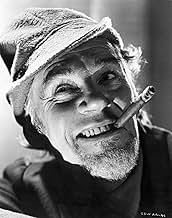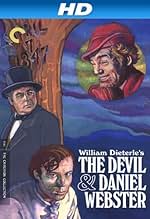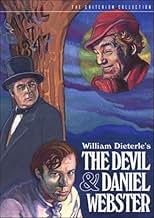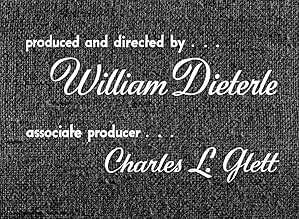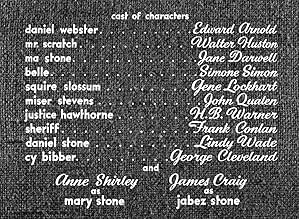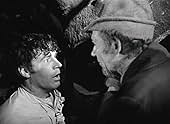Un fermier du New Hampshire du XIXe siècle conclut un pacte avec Satan pour assurer sa réussite économique, puis fait appel au célèbre orateur Daniel Webster pour l'extraire de son contrat.Un fermier du New Hampshire du XIXe siècle conclut un pacte avec Satan pour assurer sa réussite économique, puis fait appel au célèbre orateur Daniel Webster pour l'extraire de son contrat.Un fermier du New Hampshire du XIXe siècle conclut un pacte avec Satan pour assurer sa réussite économique, puis fait appel au célèbre orateur Daniel Webster pour l'extraire de son contrat.
- Réalisation
- Scénario
- Casting principal
- Récompensé par 1 Oscar
- 2 victoires et 1 nomination au total
- Spectator
- (non crédité)
- Hank
- (non crédité)
- Poker Player
- (non crédité)
- Woman
- (non crédité)
- Martin Van Buren Aldrich
- (non crédité)
Avis à la une
The Criterion DVD helped me appreciate the underrated black-and-white cinematography in this movie. It simply looks super, and even the special-effects are still pretty darned good considering the year this was made.
Character-wise, as so often is the case, the bad-guys are the most interesting in the movie. The best was Walter Huston playing "Scratch" (the Devil) and Simone Simon playing a female helper of his. Simon has the allure in this story to drive leading character "Jabez Stone" away from his sweet wife "Mary" (Anne Shirley).
Depressed and whining over his financial state of affairs and general lot in life, "Jabez" is ripe pickings for the wily "Scratch" and his cohort. The Devil makes Stone sign away his soul for money, prosperity, power, etc. Jabez gets carried away with his greed and winds up learning some valuable lessons.
Meanwhile, Edward Arnold plays "Daniel Webster," a folk hero during this time period, a man revered by all in New England. He winds up defending Jabez in a court-like scene i the end to see if he can win back the man's soul. Arnold is captivating in his role as Webster and gives an old-fashioned patriotic message at the end which would make today's Hollywood filmmakers sick.
Craig, who gets 12th billing in this film - go figure - has the most lines in the movie! How can be ignored, not only on the DVD and VHS boxes but on the bottom of the credits on this IMDb cast page? Craig overacts in his role and, thus, becomes a little annoying at times. Shirley might have been the most attractive I've ever seen here, mainly because of her strong, Christian character and down-home plain beauty that shines through in this character, Jabez's faithful wife "Mary." (She also gets slighted in the billing.)
Overall, this is a different story than anything you've seen. It's interesting, nicely directed by William Dieterle and photographed by Joseph August. Sadly, the latter died later in this decade with a heart attack. His last picture was another visual wonder: "Portrait Of Jennie."
Funny: Huston as ol' Mr. Scratch was SO good. Very funny, cynical wit. Lots of little things that stand out from him, all the odd places he turns up. He's everywhere, leading the band at the parade for Dan'l, in Washington whispering in the senator's ear, playing a mean fiddle at the barn dance. His insults to Jabez Stone were priceless. The bit at the end of him ravenously devouring this huge pie was a really funny demonstration of his greed, and the final moments of examining his book for the next target are priceless.
Creepy: Between all the funny stuff were the implications of hell and damnation, but especially terror and hopelessness (Stone and Miser Stevens). The visitors at Stone's new mansion really creeped me out good. Also creepy was the infamous scene where Miser Stevens recently harvested soul comes flying out of Scratch's jacket pocket screaming for help. This also counts as funny, at least when my five year old nephew and I go around effecting high-pitched squeals begging "Help me Neighbor Stone."
Sexy: Belle, the French nanny/whore that Scratch sent Jabez was hotter with her clothes on and no direct sexual behavior than the hookers making out in the elevator to entertain Al Pacino in "The Devil's Advocate." Note the exact tone and body language of her mocking rebuff to Stone at the barn dance saying "Oh, NO Mr. Stone- your place is with your WIFE."
The hottest thing in the movie (and one of the creepiest things) is the scene where she is singing some evil otherworldly lullaby to Stone's infant son. Rewind and watch it closely a couple of times. What was she singing?
Surely this is one of the greatest forgotten movies of the era. This should be making some of those AFI top 100 list thingeys.
The devil then uncovers a buried treasure of Hessian gold and from that moment on, Stone prospers (to the detriment of his friends and neighbors). Local politician Daniel Webster (Edward Arnold) is godfather to Stone's new baby and passes thru town regularly to socialize and imbibe with the locals. When the due date for reaping his soul arrives, it's to Webster that Stone turns to argue his way out of going to Hades for all eternity in a supernatural courtroom scene with famous disgraced and dishonored Americans - themselves in Hades - as the jury.
William Dieterle's nearly surrealistic settings and camera work (by Joseph August) add just the right touch of menace and fantasy to the stark New Hampshire settings. Simone Simon plays a seductive assistant of the devil whose purpose is to keep Stone's heart and attention away from his timid yet insightful wife who might somehow set him back on the right path.
Walter Huston was Oscar nominated for his performance as the devil and Edward Arnold plays Webster as big as all outdoors - a man with appetites and a love of life to match his girth. New England is portrayed as a rural place not too far from its Puritan roots.
Made in 1941, and dealing in themes of religion and patriotism, it might have been a shrill production had it been made any later once the war years had lots of films getting heavy handed when dealing with either of those subjects.
What seemed startling in 1941 feels mostly creaky by today's standards, but there are still some fresh moments of film making in this one. William Dieterle was obviously open to experimentation when it comes to the use of cinematography and sound, and the movie has a striking visual look. The plot is mostly connect the dots, and there are no real surprises, but I don't know that one watches a morality tale for surprises in the first place.
Walter Huston is extremely creepy as the Devil (aka Mr. Scratch). He received a Best Actor Academy Award nomination for his performance even though, based on sheer screen time, he really has more of a supporting role. But he's so effective when on screen that his presence dominates the film even when he's physically absent, which probably accounts for the lead nomination.
Edward Arnold is pretty good too as Daniel Webster. Also standing out is Jane Darwell (Ma Joad in "The Grapes of Wrath") as a hardened farm mother.
Parts of this film have a wicked sense of humour, which I thoroughly enjoyed. The trial at the end (with a literal jury of the damned), is especially amusing.
On a sidenote, the film was successful in capturing the 1941 Academy Award for Best Dramatic Score.
Don't expect to see any points made that haven't already been made a thousand times in a thousand other movies, but enjoy the originality of the film technique on display.
Grade: A-
**** stars outta ****, do see it.
Le saviez-vous
- AnecdotesWilliam Dieterle had a habit of directing with white gloves on. Robert Wise said that everyone thought it was because he had a germ or dirt phobia. During shooting of one scene, Dieterle noticed there wasn't enough mud on a carriage wheel. He pulled off his gloves, grabbed some mud, rubbed it onto the wheel, then wiped his hands on his pants and put the gloves back on to continue directing.
- GaffesCharacters in this film set in pre-Civil War America routinely use the phrase "loan shark" despite the fact that it came into the English language between 1900 and 1905.
- Citations
Mr. Scratch: You shall have your trial, Mr. Webster. But I'm sure you'll agree, this is hardly the case for an ordinary jury.
Daniel Webster: Let it be the quick or the dead, so long as it is an American judge and an American jury!
Mr. Scratch: 'The quick or the dead!' You have said it.
[he stomps on the barn floor; a door opens]
Mr. Scratch: You must pardon the leathery toughness of one or two.
Jabez Stone: [afraid] Mr. Webster!
[a line of ghosts begin entering from the trapdoor]
Mr. Scratch: Captain Kidd - he killed men for gold. Simon Girty, the renegade - he burned men for gold. Governor Dale - he broke men on the wheel. Asa, the Black Monk - he choked them to death. Floyd Ireson and Stede Bonnet, the fiendish butchers. Walter Butler, King of the Massacre. Big and Little Harp, robbers and murderers. Teach, the Cutthroat. Morton, the vicious lawyer... and General Benedict Arnold. You remember him, no doubt.
Daniel Webster: A jury of the damned...
Mr. Scratch: [laughs] Dastards, liars, traitors, knaves. Your suggestion, Mr. Webster - 'the quick or the dead.'
Daniel Webster: This is outrageous, I asked for a fair trial...
Mr. Scratch: Americans, all.
- Crédits fousFor some prints released under the title "The Devil and Daniel Webster", the opening credits start with the phrase "in front of the camera..." followed by a list of names only of the primary cast (no character names) and then the phrase "in back of the camera..." followed by a list of names only of the primary production crew, without their job roles, ending with the phase "all collaborated on the picture...." Then the title card is shown, with a story credit to Stephen Vincent Benet, and the note "this picture was originally shown with the title 'all that money can buy'." The title card is all in lower case. Finally, the opening prologue is shown as noted in another crazy credit item.
- Versions alternativesOver the years, this film was re-released more than once, partly because of its poor box office, and gradually cut down to 85 minutes. It remained in this form for many years, until it was recently restored to its full length. When this was done in the 1990s, it was unfortunately all too easy to tell which sections are restored... all the footage from the 85 minute version was in absolutely pristine, mint condition, while the long-lost, formerly missing footage has less than perfect sound and picture quality. However, the quality has been considerably improved on the DVD and on recent TV showings.
- Bandes originalesCome, Ye Thankful People, Come
(uncredited)
Music by George J. Elvey
Lyrics by Henry Alford
Meilleurs choix
- How long is The Devil and Daniel Webster?Alimenté par Alexa
Détails
- Date de sortie
- Pays d’origine
- Langue
- Aussi connu sous le nom de
- The Devil and Daniel Webster
- Lieux de tournage
- Société de production
- Voir plus de crédits d'entreprise sur IMDbPro
- Durée1 heure 47 minutes
- Couleur
- Rapport de forme
- 1.37 : 1
Contribuer à cette page



